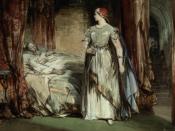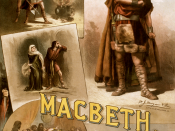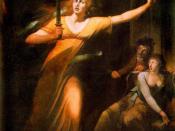Macbeth's first two soliloquies, at the end of Act 1 and the beginning of Act 2, are similar in some ways, and different in others. Macbeth tries to decide whether or not to kill Duncan in the first soliloquy, and in the second is responding to a vision of a dagger pointing to Duncan's chamber.
In his first soliloquy, Macbeth cannot decide whether to kill Duncan in the hope of taking his place as king. At first he thinks "If it were done when 'tis done..." hoping that after Duncan was killed, there would be no consequences. However he realises that there would be many consequences. He says "Bloody instructions, which being taught, return / to plague th'inventor", meaning that if teaches the people of Scotland to kill, then they will kill him. He also considers the fact that he is Duncan's "kinsman and his subject... / Who should against his murder shut the door, / Not bear the knife..."
He finishes saying he has only "Vaulting ambition which o'erleaps itself / And falls on th'other-".
In his second soliloquy, at the end of Act 2 Scene I, he sees a dagger, hovering in mid air. He reaches out to try to grab it, but "I have thee not, and yet I see thee still." The dagger points towards Duncan's chamber, beckoning. Rather that being too scared, he thinks and wonders whether it is "a false creation / Proceeding form the heat-oppressed brain" or some sort of oracular vision. The dagger starts spurting "gouts of blood". The bell rings, and he leaves to kill Duncan.
Macbeth's conscience plays an important role in his decision not to kill Duncan in his first soliloquy. He thinks how innocent and unsuspecting Duncan is, and compared him to a...


